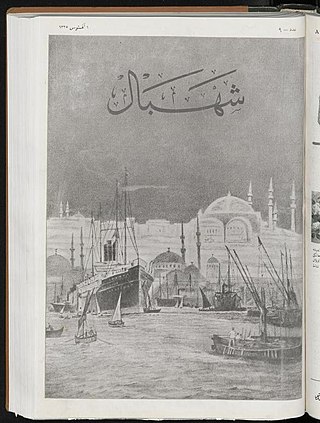| Women in Turkey |
|---|
 |
Turkish women writers refers to Turkish women contributors to Turkish literature. [1] The area is parallel to Women's writing in English.
| Women in Turkey |
|---|
 |
Turkish women writers refers to Turkish women contributors to Turkish literature. [1] The area is parallel to Women's writing in English.
During the Ottoman era, there were only a few woman poets and novelists. Professor Nazan Bekiroğlu gives the priority to two woman poets; Zeynep Hatun and Mihri Hatun who lived in the 15th century. [2] But probably the best known woman poet was Fitnat Hanım of the 18th century. The first Ottoman novelists were Zafer Hanım who was the first author of a novel published in 1877 and Fatma Aliye who is considered by many as the first Turkish female novelist. ( Hatun and Hanım are titles equivalent to "lady"). Fatma Aliye's sister Emine Semiye Önasya was also a novelist and textbook author.
The number of women poets and novelists increased sharply during the Turkish Republic (after 1923). The first novelists during the Republican era were Azmiye Hami Güven, author of a novel, Hemșire Nimet (Nimet, the Nurse), and several published stories and Halide Edib Adıvar.
The Oxford Guide to Literature in English Translation (2001) notes a boom in women's writing, but notes that these writers have failed to attract attention outside Turkey. [3] One of the first major anthologies of Turkish women authors was a collection translated by Nilüfer Mizanoğlu Reddy (1988). [4]
Prose of the Republic of Turkey covers the "Turkish Prose" beginning with 1911 with the national literature movement.

Halide Edib Adıvar was a Turkish novelist, teacher, and a nationalist and feminist intellectual. She was best known for her novels criticizing the low social status of Turkish women and what she saw from her observation as the lack of interest of most women in changing their situation. She was a Pan-Turkist and several of her novels advocated for the Turanism movement.
Halide Nusret Zorlutuna was a Turkish poet and novelist.
Sanem Çelik is a Turkish actress, artist and dancer. Her series Aliye and Kara Melek has record-breakings Turkish Tv series.
Nazan Bekiroğlu is a Turkish novelist and academician.

Fatma Aliye Topuz, often known simply as Fatma Aliye or Fatma Aliye Hanım, was a Turkish novelist, columnist, essayist, women's rights activist and humanitarian. Although there was an earlier published novel by the Turkish female author Zafer Hanım in 1877, since that one remained her only novel, Fatma Aliye Hanım with her five novels is credited by literary circles as the first female novelist in Turkish literature and the Islamic world.

The Women's Library and Information Centre Foundation (WLICF) is the first and only women's library in Turkey. It was founded in Istanbul in 1989 and opened on April 14, 1990, mainly to assist research on the history of women. The library has assigned itself the mission of acquiring, protecting, and preserving the women-centred intellectual capital in Turkey with an emphasis on improving accessibility of information.
Emine Semiye Önasya, mostly known as Emine Semiye and Emine Vahide, was a Turkish writer, teacher, activist, and early feminist. She thought that education plays an important role in the emancipation of women.
Turkish women in academics refers to Turkish women who make scientific research or teach in the universities in Turkey and abroad.

Ateşten Gömlek is a 1923 black-and-white Turkish drama film, co-produced by Kemal Seden and Şakir Seden, written and directed by Muhsin Ertuğrul based on a novel of the same title by Halide Edib Adıvar. The movie marks a milestone in the cinema of Turkey as for the first time ever Turkish Muslim actresses, namely Bedia Muvahhit and Neyyire Neyir, featured in a movie. It is in general about some events during the Turkish War of Independence (1919–1923). Its remake with the same title was released in 1950, directed by Vedat Örfi Bengü.

The Ottoman journal Shehbal was published in Istanbul between 1907 and 1914. The first issue appeared on 1 March 1907. Its publisher Hüseyin Saadeddin Arel (1880–1955), technically a lawyer, was a well-known musicologist and composer of 20th-century classical Turkish music. Altogether 100 numbers were issued every two weeks, at the first and fifteenth day of each Maliye-month respectively, totaling 20 pages. The page format more or less equaling the German DIN-size A3 as well as new printing techniques like the three-color printing with countless photographs and illustrations make the journal especially remarkable.
Hanımlara Mahsus Gazete was an Ottoman women's magazine which was published in Istanbul from 1895 to 1908. It was one of the long-term publications in the Ottoman Empire which shaped the literary traditions of the Ottoman women. However, due to the intensive censorship during the reign of Sultan Abdulhamit the magazine mostly featured conventional topics.
Mehâsin was a monthly women's magazine which was published in the Ottoman Empire between 1908 and 1909. It was one of the publications started in the aftermath of the Young Turk Revolution and was subtitled as Hanımlara Mahsus. It is known for being the first color women's magazine in the Empire.